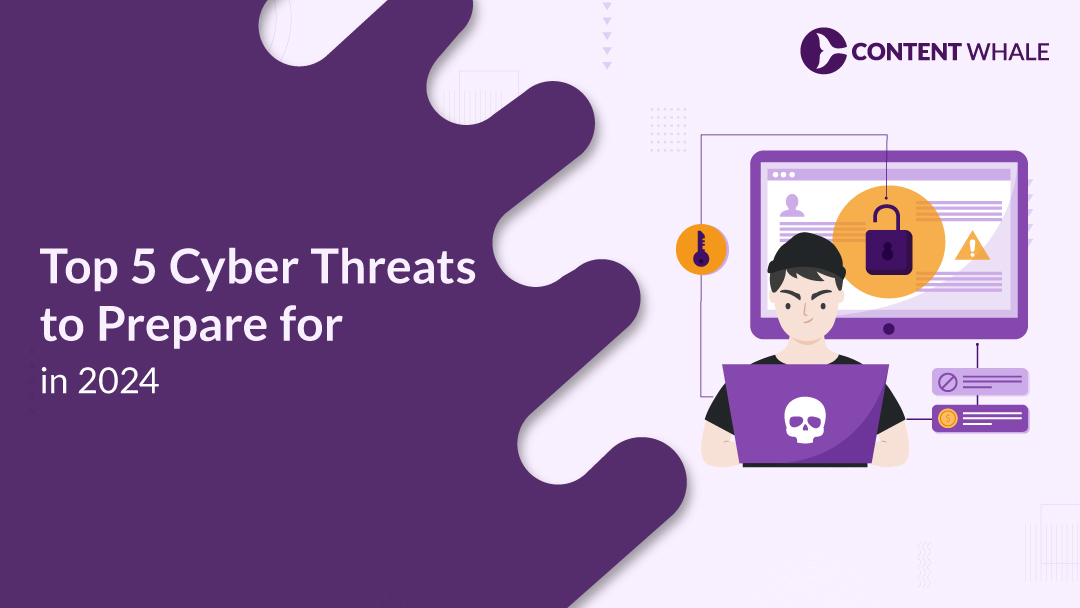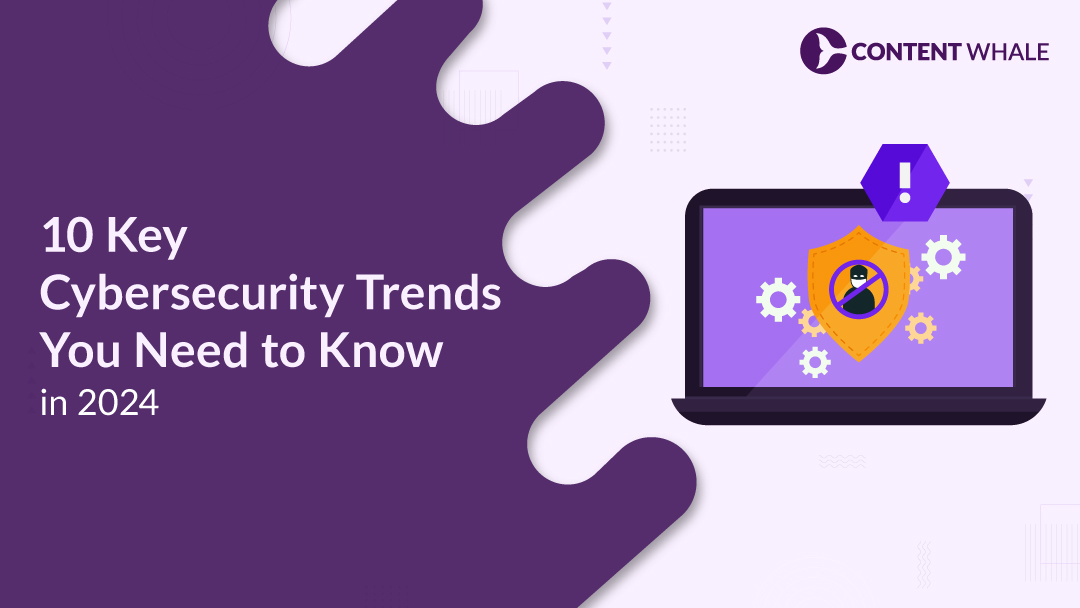As businesses and individuals continue to rely more heavily on digital infrastructure, cyber threats in 2024 are becoming increasingly sophisticated. Attackers are constantly evolving their tactics, with new vulnerabilities emerging every day. Keeping an eye on the latest cybersecurity trends 2024 is no longer optional—it’s necessary for survival in the digital space.
From AI-powered malware to targeted phishing attacks, the most dangerous cyber attacks are more difficult to detect and defend against than ever before. Whether you’re a business owner or a regular internet user, understanding these emerging cyber threats 2024 can help you stay ahead of the curve and protect your valuable data.
By staying informed and implementing proactive cybersecurity measures, you can minimize the risk of falling victim to the next wave of future cyber risks. Let’s take a look at the top cyber threats you need to be aware of in 2024 and beyond.
1. AI-Powered Cyber Attacks
The rise of AI cyber threats is one of the most alarming developments among cyber threats in 2024. Hackers are leveraging artificial intelligence to create more sophisticated and targeted attacks that are harder to detect and mitigate.
Key AI-Driven Attack Strategies:
- Automated Phishing Campaigns: AI enables cybercriminals to generate highly convincing phishing emails by mimicking human behavior. These attacks blend seamlessly into a user’s inbox, making detection much more difficult.
- AI-Powered Malware: Traditional security measures struggle to keep up with AI-powered malware, which can learn and adapt to defenses in real-time. This advanced malware in 2024 is designed to evade detection systems and cause more damage.
- Deepfake Technology: Attackers now use AI to generate deep fakes—realistic but fake audio or video files. These files can impersonate high-level executives or other trusted figures to deceive targets, leading to data breaches or financial loss.
2. Supply Chain Attacks
Among the cyber threats in 2024, supply chain attacks are becoming one of the most disruptive and dangerous. These attacks target vulnerabilities within a company’s third-party suppliers or partners, making it easier for cybercriminals to infiltrate larger systems indirectly.
a) How Supply Chain Attacks Work:
- Third-Party Vulnerabilities: Attackers compromise a less secure supplier or vendor, using their access to infiltrate the main organization. Once inside, they can steal sensitive data, deploy malware, or disrupt operations.
- Recent Incidents: High-profile examples like the SolarWinds and Kaseya attacks have demonstrated how quickly a single supply chain vulnerability can lead to widespread chaos across multiple businesses and sectors.
b) Protecting Against Supply Chain Attacks:
- Vetting Suppliers: It’s essential to assess the cybersecurity practices of all vendors and suppliers to ensure their security standards match your own.
- Implementing Stronger Controls: Multi-layered defenses like encryption, strict access controls, and network segmentation can reduce the risk of a breach spreading from a supplier to your business.
3. Zero-Day Exploits
Zero-day exploits continue to rank among the most dangerous cyber attacks as they target unknown vulnerabilities in software or hardware. These threats pose significant challenges because developers have no time to patch the flaw before attackers exploit it, making them one of the most challenging cyber threats in 2024.
a) What Are Zero-Day Exploits?
- Unpatched Vulnerabilities: Attackers take advantage of software flaws that developers haven’t discovered yet. Once the vulnerability becomes known, it’s often too late, as attackers have already found a way in.
- Rapid Exploitation: Hackers quickly weaponize these exploits, giving companies little time to respond, resulting in breaches, malware infiltration, or data theft.
b) Addressing Zero-Day Exploits:
- Continuous Monitoring: Utilizing real-time threat intelligence and monitoring tools can help identify suspicious activity, giving businesses a chance to mitigate damage before it escalates.
- Regular Patch Management: While zero-day threats target unpatched vulnerabilities, maintaining a robust patch management strategy ensures that once a fix is available, it is deployed immediately.
| # | Type of Zero-Day Exploit Attack | Description | Prevention Method |
| 1 | Web Browser Exploits | Attackers exploit unpatched vulnerabilities in browsers, enabling drive-by downloads or executing harmful scripts. | Web Application Firewall (WAF): Filters malicious traffic targeting browser vulnerabilities. |
| 2 | Operating System Exploits | Vulnerabilities in the OS allow attackers to gain system control, potentially leading to full compromise. | Regular Patch Management: Quickly apply security patches to close gaps. |
| 3 | Document-Based Exploits | Attackers embed malware in document files (e.g., PDF, Word) to exploit vulnerabilities in the application opening them. | Next-Generation Antivirus (NGAV): Detects abnormal behavior in document interactions. |
| 4 | IoT Device Exploits | Insecure IoT devices provide attackers entry points, which they can use for distributed attacks or to create botnets. | Network Segmentation: Isolates IoT devices from critical systems to limit attack scope. |
| 5 | Firmware and Hardware Exploits | Exploits targeting routers, switches, or hardware components that lack regular security updates. | Vulnerability Scanning: Identifies potential hardware vulnerabilities early. |
| 6 | Email Attachment Exploits | Malware hidden in email attachments exploits vulnerabilities in file types like Excel, PDF, or Word. | Employee Training: Teach employees to recognize and avoid suspicious email attachments. |
4. Phishing Attacks
Phishing continues to be one of the most dangerous cyber attacks, and its evolution makes it a significant part of cyber threats in 2024. Attackers are refining their tactics, making phishing harder to detect and more damaging to businesses and individuals.
a) How Phishing is Changing:
- Sophisticated Social Engineering: Modern phishing attacks use advanced social engineering techniques, tricking victims into sharing sensitive information. Hackers now create highly personalized emails that appear to come from trusted sources.
- Phishing Trends 2024: The use of AI in phishing has increased, enabling attackers to craft more convincing messages. This also includes the rise of “spear phishing,” where attackers target specific individuals or businesses for greater impact.
b) Preventing Phishing Attacks:
- Employee Training: Educating employees about the latest phishing methods is one of the most effective ways to reduce risks. Training should focus on identifying suspicious emails, links, and attachments.
- Multi-Factor Authentication: Using two-factor authentication (2FA) adds an extra layer of security, making it harder for attackers to gain unauthorized access, even if credentials are compromised.
| # | Prevention Method | Description |
| 1 | Security Awareness Training | Regularly train employees to recognize phishing attempts, using real-world examples and simulations. |
| 2 | Two-Factor Authentication (2FA) | Enforce 2FA on all accounts to add an extra layer of security, even if passwords are compromised. |
| 3 | Email Filtering & Anti-Phishing Tools | Implement email security solutions that filter out phishing emails and warn about suspicious links or attachments. |
| 4 | Verify Sender Information | Always double-check email addresses and domains to ensure the sender is legitimate before interacting. |
| 5 | Avoid Clicking Suspicious Links | Never click on links or download attachments from unfamiliar or unexpected sources. |
5. IoT-Based Attacks
As more devices connect to the internet, IoT-based attacks are becoming a critical part of cyber threats in 2024. The Internet of Things (IoT) includes a wide range of devices, from smart home systems to industrial sensors, many of which lack strong security measures. This creates new vulnerabilities that attackers can exploit.
a) Key Vulnerabilities in IoT:
- Weak Security in Devices: Many IoT devices are shipped with default credentials and minimal security, making them easy targets for hackers. These devices often do not receive regular updates or patches, leaving them open to exploitation.
- Large-Scale DDoS Attacks: Hackers can hijack thousands of vulnerable IoT devices to launch distributed denial-of-service (DDoS) attacks. These attacks overwhelm a target’s network, causing downtime and financial losses. The infamous Mirai botnet attack demonstrated the destructive potential of such large-scale IoT-based DDoS attacks.
b) Securing IoT Devices:
- Regular Updates and Patches: Keeping IoT device firmware up to date can help close security gaps that attackers may exploit.
- Network Segmentation: Isolating IoT devices from critical systems reduces the risk of widespread damage if an attack occurs.
Conclusion
The rise in cyber threats in 2024 highlights the need for businesses and individuals to stay proactive in their cybersecurity efforts. With the increasing sophistication of AI cyber threats, the persistence of ransomware 2024, the evolution of phishing trends 2024, and the vulnerabilities posed by IoT-based attacks, the digital landscape has never been more dangerous.
Understanding these emerging cyber threats 2024 and adopting a layered security approach can help reduce the risks associated with these future cyber risks. Regular software updates, employee education, and advanced threat detection systems will play a pivotal role in defending against the most dangerous cyber attacks of this year.
The time to act is now. Ensure that your cybersecurity strategies are up to date and that your teams are well-informed. Staying ahead of these cybersecurity trends 2024 can protect both personal data and business assets from potentially devastating attacks.
——
This blog showcases Content Whale’s expertise in creating SEO-optimized content that doesn’t just rank—it drives growth. If you’re ready to enhance your online presence, increase traffic, and achieve your business objectives, we’re ready to help. Get in touch with us today, and let’s develop content that fuels your success.
FAQs
1. What are the most dangerous cyber threats in 2024?
The most dangerous cyber attacks include AI-powered threats, ransomware, phishing, supply chain breaches, and zero-day exploits. These emerging cyber threats 2024 are becoming more advanced, making it crucial to stay vigilant.
2. How can businesses protect against ransomware in 2024?
To combat ransomware in 2024, businesses should implement regular data backups, use advanced endpoint protection, and ensure all software is updated. Employee training on avoiding phishing emails is also vital.
3. What is AI’s role in future cyber threats?
AI cyber threats are on the rise as attackers use AI to automate phishing attacks, create sophisticated malware, and conduct deep fake scams. These tools make attacks more convincing and harder to detect, posing significant future cyber risks.
4. Why are insider threats increasing?
Insider threats are growing due to remote work environments and lack of proper monitoring. Employees can unintentionally or maliciously expose sensitive data, increasing the need for strong internal security measures.
5. What are the best practices to defend against phishing?
To prevent phishing, businesses should deploy multi-factor authentication, use spam filters, and regularly train employees on recognizing phishing trends 2024. Implementing these measures helps reduce the risk of data breaches.





